by tmoffett | Sep 11, 2010 | Color, Landscape, Photographic Philosophy
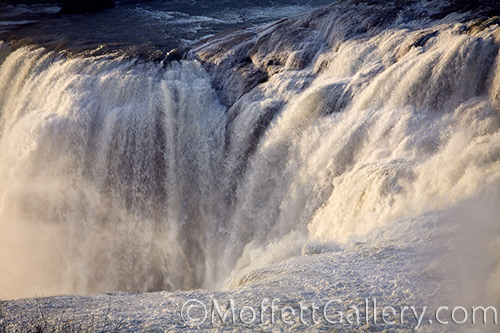
Vortex, Shoshone Falls
Normally I like to blur my photos of running water, but on this occasion I changed my mind. The water flow was so high that blurring the motion of the water going over the falls caused the whole image to look mushy. With streams and waterfalls I prefer a lower flow rate as that will create a nice ribbon effect with the bands of water. When slowing the shutter down with this much flow, the ribbons of detail disappear and everything becomes white. With this in mind, I decided to speed up the shutter and freeze the motion of the water as it went over the edge. I thought it was an interesting perspective, one that I have not seen before.
by tmoffett | Sep 10, 2010 | Black and White, Landscape, Photo tips
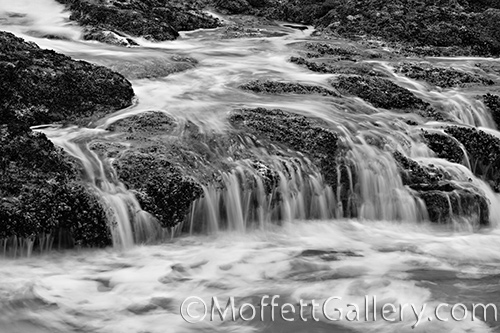
Shoreline, Yachats, Oregon
The evening we arrived in Yachats we were met with rain, however that did not stop me from photographing. We climbed out on the rocky shelf overlooking the sea and watched the waves come in. It was quite a spectacle. The waves would crash into the rock and spray seawater everywhere. The water would rush up on the shelf and then slowly retreat to the ocean just in time to meet the next wave. I photographed the waves for a while and then turned my camera inland and watched and photographed the retreating water. It appeared as a river flowing downstream and over small falls. As I photographed, Christeena was holding an umbrella, not knowing which way to hold it. Should she keep the rain off of me and the equipment of protect me from the ocean spray? It didn’t matter. Either way I got wet!
I often have students say they couldn’t photograph because of inclement weather. I only need to show them a few images and they realize that they are only making excuses. Some of my best photographs have been made during stormy weather. Students quickly learn that I won’t accept excuses of this kind, as I know, and they soon learn, that great opportunities are missed by not photographing during a storm. They just need to find a way to keep their gear dry and protected. This can be accomplished quite easily with an umbrella or even a garbage bag. When that is accomplished, a whole new world of creativity and opportunity are opened up. I love a good storm.
by tmoffett | Sep 9, 2010 | Color, Composition, Landscape
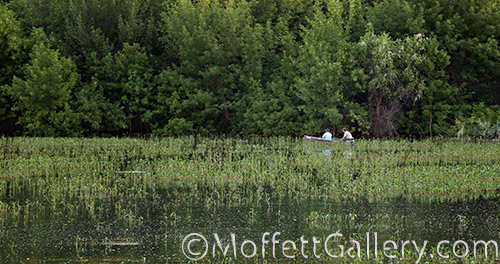
In Search of Bass
Yesterday I posted a little bit about black and white. While I do love black and white, I have been into color a lot more the past couple of years. Much of my color work, however is monochromatic in nature. I just can’t get away from that look. One color, great tones, it just works.
What I like about this image is the fishermen. Everything is green except them. That draws the attention to them and breaks up the color just enough to make it work. Without them, this image just does not work at all. Along with the monochromatic color, repetition is at play here. Again, it is the two fishermen that break up the repetition enough to make it interesting. I was fortunate to be at the right place at the right time to capture the image.
by tmoffett | Sep 8, 2010 | Black and White, Composition, Landscape, Photo tips
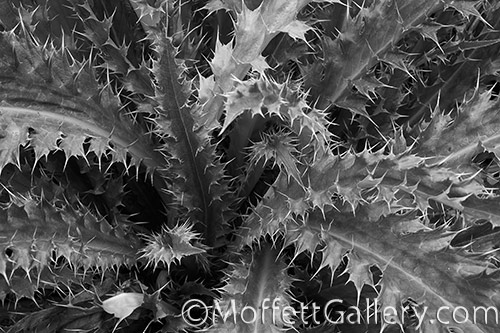
Untitled
When working in black and white, there are many factors to consider while making the photograph. Tonal range, local contrast and composition to name a few. Usually the overall tonal range should go from a deep black to bright white while maintaining good detail throughout. If the exposure is off at all, loss of detail on one end of the scale or the other becomes a problem. Light quality is ever important in creating images with a great tonal range. Once the overall tonal range is established, local contrast, the contrast between to adjacent objects in the image, must be controlled. In the darkroom, I control this by using different grades of paper. With digital, I use curves adjustment layers with layer masking. When everything is just right you will end up with a print with rich tones and great detail.
Composition is another whole ball game. In the above image, line, repetition, texture and rule of thirds are all important. They work together to lead the viewers eye from the outside down inside the plant. While traveling down the plant, every prickly point is rendered in rich detail. I begin to feel the image. I know I do not want to touch it. It is sharp and prickly. the eye is led to the lower left quadrant, off center just enough to create interest.
I love black and white. Quality black and white photography is becoming a lost art. Digital cameras have made it too easy that we forget at times to slow down and think before pressing the shutter. Shooting by instinct is great, but first learn technique so that when shooting by instinct or feeling you get the tones and composition right. It will improve your photography, I promise!
by tmoffett | Sep 7, 2010 | Color, Landscape, Photographic Philosophy, Ramblings
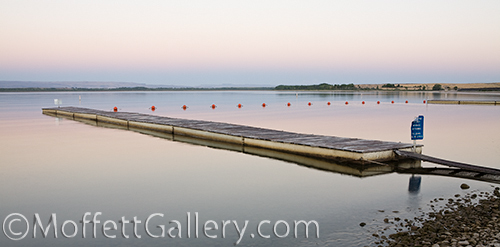
Morning Calm, Lake Lowell
I had not been out to photograph just for me in a couple of weeks. I had a need to get out and make some exposures. Anywhere. It didn’t even matter if the photographs were very good. I get that way sometimes. I feel that I need to do something, so I do it. Saturday morning was that day. I arose at 6:00 and grabbed my gear and went. I ended up at the lake just before sunrise. It was beautiful. When I arrived, I could only see one boat on the water, and it sat motionless. Must have been fishermen. There was not a wave on the water. The only disturbances were a few fish jumping just off shore. The water and sky were filled with subtle pastel colors. I soaked in the feeling. It was refreshing to the soul. I walked and thought and meditated. I photographed. Life is good.
Not long after shooting this image, more boats arrived and the water got choppy from all of the action. The noise level increased dramatically as people arrived for the holiday weekend. The sun rose and the light quality diminished, but I had my fix. I beat the rush. I made photographs. I cleared my head. I am now ready to tackle whatever life throws at me, and if it gets tough, I’ll go photographing again. It is my therapy. I love life.







Recent Comments